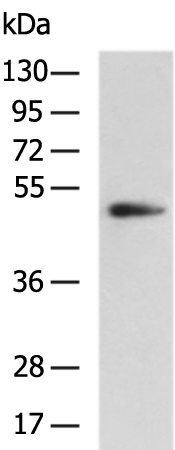
| WB | 咨询技术 | Human,Mouse,Rat |
| IF | 咨询技术 | Human,Mouse,Rat |
| IHC | 咨询技术 | Human,Mouse,Rat |
| ICC | 技术咨询 | Human,Mouse,Rat |
| FCM | 咨询技术 | Human,Mouse,Rat |
| Elisa | 1/5000-1/10000 | Human,Mouse,Rat |
| Aliases | KAT1 |
| WB Predicted band size | 50 kDa |
| Host/Isotype | Rabbit IgG |
| Antibody Type | Primary antibody |
| Storage | Store at 4°C short term. Aliquot and store at -20°C long term. Avoid freeze/thaw cycles. |
| Species Reactivity | Human, Mouse, Rat |
| Immunogen | Fusion protein of human HAT1 |
| Formulation | Purified antibody in PBS with 0.05% sodium azide and 50% glycerol. |
+ +
1. **"Histone acetyltransferase 1 (HAT1) promotes cell proliferation and apoptosis resistance in hepatocellular carcinoma"**
- 作者: Li X, et al.
- 摘要: 研究通过HAT1抗体分析肝癌细胞中HAT1的表达,发现其通过乙酰化组蛋白H4调控细胞周期相关基因,促进肿瘤增殖并抑制凋亡。
2. **"HAT1-mediated acetylation of histone H4 is essential for chromatin assembly in Drosophila"**
- 作者: Parthun MR, et al.
- 摘要: 利用HAT1抗体证明果蝇中HAT1对组蛋白H4的乙酰化在染色质组装中起关键作用,影响DNA复制和基因沉默。
3. **"Role of HAT1 in colorectal cancer progression via regulation of STAT3 activation"**
- 作者: Wang Y, et al.
- 摘要: 通过免疫组化(HAT1抗体)发现HAT1在结直肠癌中高表达,并揭示其通过STAT3信号通路促进肿瘤侵袭转移。
4. **"HAT1 coordinates histone dynamics during early stages of DNA repair"**
- 作者: Saredi G, et al.
- 摘要: 结合HAT1抗体的ChIP实验,发现HAT1在DNA损伤修复早期通过调控组蛋白乙酰化重塑染色质结构,促进修复因子招募。
以上文献均直接涉及HAT1抗体的应用(如Western blot、免疫荧光或ChIP),并探讨HAT1在癌症、染色质动态及DNA修复中的功能。
Histone acetyltransferase 1 (HAT1), a member of the GNAT (GCN5-related N-acetyltransferase) superfamily, is responsible for catalyzing the acetylation of histone H4 on lysine residues, particularly during chromatin assembly and nucleosome remodeling. It plays a critical role in epigenetic regulation by modulating chromatin structure and gene expression. HAT1 primarily acetylates free histone H4 but may also interact with other histones or non-histone proteins. Its activity is tightly linked to DNA replication and repair, cell cycle progression, and cellular differentiation.
HAT1 antibodies are essential tools for studying its expression, localization, and function in these processes. They are widely used in techniques like Western blotting, immunoprecipitation, immunofluorescence, and chromatin immunoprecipitation (ChIP). Researchers employ these antibodies to explore HAT1's involvement in diseases such as cancer, where dysregulated acetylation contributes to oncogenesis, or in developmental disorders linked to epigenetic aberrations. Some studies also investigate its interaction with chaperones (e.g., ASF1B) during histone deposition. Commercial HAT1 antibodies are typically raised against specific epitopes, often validated for cross-reactivity and species specificity (e.g., human, mouse). Recent work highlights its dual role in cytoplasmic histone acetylation and potential nuclear functions, making these antibodies vital for dissecting context-dependent regulatory mechanisms.
×